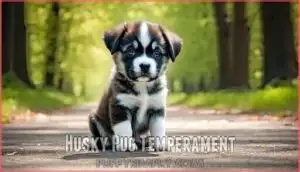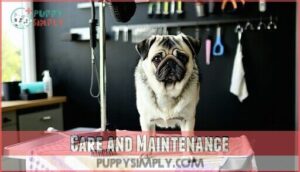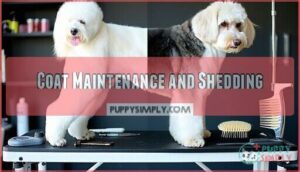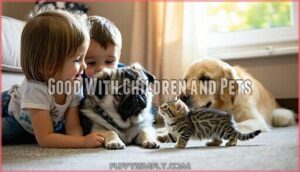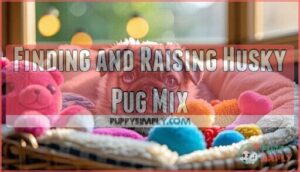This site is supported by our readers. We may earn a commission, at no cost to you, if you purchase through links.

You’ll get a medium-sized dog weighing 30-60 pounds with a unique look that’s part athletic, part adorable wrinkles.
These "Hugs" are incredibly loyal and affectionate, making them fantastic family pets who crave attention and interaction.
They’re energetic but not overwhelming, perfect for active families who want a companion that’s both playful and cuddly.
While they’re generally healthy with a 12-15 year lifespan, you’ll need to stay on top of grooming and exercise needs.
There’s more to keep in mind before bringing one home, considering their need for attention.
Table Of Contents
- Key Takeaways
- Husky Pug Mix Overview
- Husky Pug Temperament
- Health and Lifespan
- Care and Maintenance
- Husky Pug Mix Costs
- Training and Exercise Needs
- Grooming and Cleaning
- Family Life and Compatibility
- Finding and Raising Husky Pug Mix
- Frequently Asked Questions (FAQs)
- What is a husky Pug mix called?
- How much is a Pug husky mix?
- What is the rarest husky mix?
- Is a husky mix a good family dog?
- How much does a Husky Pug Mix cost?
- How long do Husky Pug Mixes typically live?
- Does the Husky Pug Mix bark a lot?
- Are Husky Pug Mixes easy to train?
- Does a Husky Pug Mix need a lot of space?
- Do husky pug mixes bark excessively or howl?
- Conclusion
Key Takeaways
- You’ll get a unique medium-sized companion – Your Husky Pug mix will weigh 30-60 pounds with varied features, from the Husky’s athletic build to the Pug’s adorable wrinkles, creating a one-of-a-kind look that’s both striking and endearing.
- They’re incredibly loyal but need constant attention – Your "Hug" will crave human interaction and may develop separation anxiety if left alone too long, making them perfect for families who can provide the daily affection and engagement they desperately need.
- Expect significant exercise and grooming commitments – You’ll need to provide 30 minutes to 2 hours of daily exercise, depending on which parent they favor, plus weekly brushing and daily facial crease cleaning to prevent health issues.
- Budget for higher costs but enjoy longer companionship – You’ll spend $800-$2,000 upfront and $1,200-$2,000 annually on food, vet care, and grooming, but you’ll get 12-15 years with a healthy, devoted family member who’s excellent with children and other pets.
Husky Pug Mix Overview
You’ll discover that the Husky Pug mix combines the best traits from both parent breeds, creating a unique companion with varied physical features and temperament.
This crossbreed typically stands 10 to 23 inches tall and weighs between 14 to 60 pounds, with coat colors ranging from black and gray to fawn and white combinations.
Physical Characteristics
Your husky pug mix will surprise you with incredible size variations, ranging from 10 to 23 inches tall and weighing between 14 to 60 pounds.
Prepare to be amazed by your Husky Pug mix’s impressive 10 to 23-inch stature and 14 to 60-pound charm!
These adorable pups showcase diverse facial traits, from the Husky’s long muzzle to the Pug’s distinctive folds.
Eye coloration varies dramatically, featuring stunning blues, ambers, or even bi-colored combinations that’ll melt your heart, with incredible size variations being a notable aspect of their appearance.
Coat Types and Colors
Your Hug’s coat genetics create fascinating variety.
You’ll find short, fine coats like Pugs or long dense coat resembling Huskies.
Common color combinations include black, gray, red, silver, and white markings.
Some dogs develop a thick double coat requiring frequent brushing.
Shedding frequency varies by genetics – expect seasonal changes affecting grooming needs.
Color rarity depends on parent traits.
Certain coat colors, such as agouti and white, are considered more rare due to their unique genetics.
Facial Features
Your pup’s face will be a delightful surprise blend of both parents.
The muzzle length can vary dramatically – some inherit the Husky’s long muzzle while others get the Pug’s short noses. Eye coloration ranges from deep blue to amber, sometimes even different colors in each eye.
- Facial wrinkles and creases may appear around the nose area, requiring daily cleaning
- Ear shape varies from pointy Husky ears to floppy Pug ears within the same litter
- Mask patterns often create striking facial markings inherited from both parent breeds
Husky Pug Temperament
You’ll find that your Husky Pug mix brings together the best traits from both parent breeds, creating a dog that’s both affectionate and energetic.
This unique combination means you’ll get a loyal companion who craves attention and needs proper training to channel their intelligent but sometimes stubborn nature.
Affectionate and Loyal Nature
When you bring home a husky pug mix, you’re getting a companion dog that forms an unbreakable family bond.
These affectionate pups stick to their humans like glue, often developing protective instincts toward loved ones.
Your loyal family pet thrives on social interaction and may experience separation anxiety when left alone too long.
They’re natural companions who crave constant connection.
Energetic and Attention-Seeking Behavior
Your husky pug mix craves the spotlight like a Broadway star.
These energetic pups demand constant attention and can develop destructive tendencies without proper exercise. You’ll need to provide mental stimulation daily to prevent boredom.
Their attention-seeking behavior means they’ll follow you everywhere, wanting to be part of every family activity.
Training challenges arise when exercise needs aren’t met. To manage their energy, consider engaging in dog sports.
Socialization and Training Needs
Training your Hug requires patience and skill.
These dogs inherit stubbornness from both parent breeds, making them challenging for new owners. Experienced handlers find success through consistent approaches and early socialization training.
Essential Training Elements:
- Early Socialization – Start obedience training immediately to prevent behavioral issues
- Positive Reinforcement – Use treats and praise to overcome stubbornness challenges
- Consistency Training – Maintain daily routines matching their exercise needs
Health and Lifespan
Your Husky Pug mix will likely live 12 to 15 years with proper care.
But you’ll need to watch for breathing problems and hip issues that both parent breeds can pass down.
Regular vet visits and a healthy diet will help you catch problems early and keep your pup happy for years to come, which is crucial for preventing hip issues.
Common Health Issues
While your Hug brings endless joy, they’re prone to several health issues you should watch for.
BAOS risks cause breathing difficulties due to their shortened airways. PDE concerns affect the brain, while hip dysplasia impacts joints.
Eye problems and dermatitis care become ongoing needs.
Brachycephalic syndrome compounds these challenges, making regular monitoring essential for your pup’s wellbeing.
Average Lifespan and Diet
Your husky pug mix typically lives 12-16 years with proper care.
Their diet directly impacts longevity and health. Here’s what’ll keep your pup thriving:
- High-quality kibble with real meat as the first ingredient
- Consistent feeding schedule twice daily for adults
- Ideal weight maintenance through portion control
- Dietary supplements like omega fatty acids when needed
- Senior diet adjustments after age seven for superior canine nutrition
Regular Vet Check-Ups
Given their predisposition to health issues like BAOS and hip dysplasia, you’ll need regular vet visits every six months.
Your veterinarian will monitor vaccination schedules, parasite prevention, and dental health while tracking weight management concerns.
As your Hug ages, senior care becomes essential for catching health problems early and maintaining superior canine health throughout their lifetime.
Care and Maintenance
Your husky pug mix needs proper daily care to stay healthy and happy throughout their 12-15 year lifespan.
You’ll need to provide quality food, regular grooming, and daily exercise to meet their unique needs as a mixed breed.
High-Quality Diet and Portion Control
Your Husky Pug mix needs proper nutrition to stay healthy and avoid obesity.
Choose high-quality kibble over raw diets, which aren’t recommended for this breed.
Adult dogs need about 2 cups daily, while puppies require 3 cups split into smaller meals.
- Kibble Quality – Select premium dog food with real meat as the first ingredient
- Puppy Portions – Feed young dogs three cups daily, divided into multiple small meals
- Adult Feeding – Provide two cups of high-quality food daily for mature dogs
- Obesity Prevention – Monitor caloric content and adjust portions based on your dog’s activity level
Weekly Brushing and Nail Trimming
Regular grooming essentials keep your Hug looking their best.
Brush your dog’s coat weekly using slicker brush types for short coats or pin brushes for longer fur.
Nail clippers should trim nails every 2-3 weeks to maintain proper paw health.
Regular brushing may require a specialized dog brush.
Establish a consistent grooming schedule and grooming routine.
Check trimming frequency based on your dog’s activity level and nail growth rate.
Daily Exercise and Mental Stimulation
Beyond their adorable squished faces, these high-energy pups need serious exercise and mental stimulation to stay happy.
Plan for 30 minutes to 2 hours of strenuous activities daily, depending on which parent they favor.
Puzzle toys, interactive games, and scent work keep their minds busy. Consider agility training or canine sports to match their energy levels perfectly.
Husky Pug Mix Costs
You’ll need to budget between $800 and $2,000 for a Husky Pug Mix puppy from a reputable breeder.
Your ongoing costs will include $50-80 monthly for food, $500-1,200 yearly for vet care, and additional expenses for grooming and supplies.
Puppy Prices and Expenses
Bringing home your husky pug mix puppy means budgeting $1,000-$2,000 for initial puppy cost from reputable breeders.
Beyond puppy prices, you’ll face vaccination expenses ($100-$200), microchipping fees ($50), and spaying/neutering costs ($300-$500).
Early supplies cost another $200-$500 for essentials like crates, toys, and food, which are part of the initial costs that add up quickly, so plan ahead.
Food and Vet Care Costs
Monthly expenses for your Hug dog include high-quality food costing $30-60 and regular vet visits around $50-100.
Their dietary needs require premium kibble following a proper feeding guide. Preventative care helps avoid costly health issues later.
Consider pet insurance and emergency funds for unexpected medication costs. Insurance options typically range $20-50 monthly, covering major procedures.
Long-Term Ownership Costs
Looking at long-term ownership costs, you’ll spend about $1,200-$2,000 annually on your Husky Pug mix.
Food expenses run $300-500 yearly, while veterinary bills average $600-800.
Grooming costs add $200-300, and insurance premiums help offset potential health issues.
Don’t forget toy replacements and emergency care funds.
Proper feeding and grooming prevent costly problems down the road.
Training and Exercise Needs
Your Husky Pug mix needs consistent training and daily exercise to stay happy and well-behaved.
You’ll want to start training early since these dogs can be stubborn, and they need anywhere from 30 minutes to 2 hours of activity each day depending on which parent they take after.
Quick Tips for Training
Training your Husky Pug mix requires patience since these pups inherit stubbornness from both parents.
Start early socialization and stick to consistent routines for best results.
- Use positive reinforcement – Rewards work better than punishment for curbing stubbornness
- Practice basic obedience commands daily – Sit, stay, and come are essential foundations
- Focus on consistency training – Same rules from all family members prevent confusion
Daily Exercise Requirements
Your Husky Pug mix needs 30 minutes to 2 hours of daily exercise depending on which parent they favor.
These energetic dogs require daily walks and active play sessions. Start with shorter puppy exercise routines and gradually increase exercise intensity as they grow.
Leash training helps manage their exercise requirements while keeping them safe during outdoor activities.
Mental Stimulation and Play
Beyond physical exercise, your Hug dog needs puzzle toys and interactive games to stay mentally stimulated.
Training games and enrichment activities prevent destructive behavior when boredom strikes. Rotate chew toys weekly to maintain interest.
Social play with other dogs provides both mental and physical stimulation. Offleash play in secure areas lets your pup explore naturally while engaging their clever mind.
These dogs benefit greatly from interactive learning toys, which is an essential part of their interactive learning.
Grooming and Cleaning
Your husky pug mix’s grooming needs will vary based on whether they inherit the pug’s short coat or the husky’s thick double coat.
You’ll need to brush them 2-4 times weekly and clean their facial wrinkles daily to prevent skin problems.
Coat Maintenance and Shedding
Your Hug dog’s coat presents unique grooming requirements depending on which parent they favor.
Double-layered coat types need brushing frequency of 2-4 times weekly for proper shedding control.
Short-haired varieties require less maintenance but still shed considerably.
Seasonal shedding peaks twice yearly, demanding daily grooming during these periods.
Invest in quality grooming tools like slicker brushes and deshedding combs.
Different coat texture variations need specific approaches for ideal results, including the use of quality grooming tools.
Facial Crease Cleaning and Ear Care
Your Hug dog’s facial creases and droopy ears need regular attention to prevent skin infections. Those adorable folds of skin can trap moisture and bacteria, leading to serious problems.
Here’s your cleaning routine:
- Daily facial crease cleaning – Use gentle cleaning solution options to wipe away debris
- Weekly ear cleaning – Remove earwax buildup with cotton balls and cleaner
- Watch for crease infection signs – Redness, odor, or discharge means trouble
- Follow preventing ear infections tips from professional grooming advice
To maintain ear health, remove wax buildup regularly.
Nail Trimming and Dental Care
Regular nail trimming prevents painful splitting and scratching.
Use proper nail clippers every 2-3 weeks, cutting just the white tips.
If you need new ones, consider purchasing dog clippers.
Don’t forget dental hygiene – brush your Hug’s teeth twice weekly with dog toothpaste.
This prevents tartar buildup and gum disease while keeping bad breath at bay.
Good tartar control means breath freshening naturally follows consistent teeth brushing routines.
Family Life and Compatibility
Your husky pug mix thrives in family settings and gets along well with children and other pets when properly socialized from an early age.
You’ll need to provide plenty of attention and affection since these dogs crave human interaction and love being the center of their family’s world.
Good With Children and Pets
Your Hug dog’s affectionate nature makes them excellent family pets who genuinely enjoy being around children and other pets.
Their friendly temperament creates positive family dynamics, though supervised interactions help guarantee everyone gets along smoothly.
These gentle dogs adapt well to households with multiple pets, making them ideal choices for families seeking a loving companion who thrives on attention.
Socialization and Training for Families
Starting socialization training early makes your family dog well-adjusted around everyone.
These pups can be stubborn, so positive reinforcement works better than harsh corrections.
Focus on basic obedience commands and child interaction skills.
Family integration happens smoothly when you’re consistent with sociability training.
Their friendly nature helps, but don’t skip training tips that address stubbornness management effectively, and remember socialization training is key.
Attention and Cuddling Needs
Your Hug will crave constant companionship and become your shadow around the house.
These affectionate dogs thrive on cuddling sessions and hate being left alone for long periods.
Expect attentionseeking behaviors like pawing, whining, or following you everywhere.
Balance playtime with cuddle time to prevent separation anxiety.
This family pet needs daily affection display to stay emotionally healthy and happy with strong owner attachment.
Finding and Raising Husky Pug Mix
Finding a healthy Husky Pug mix puppy requires research to locate reputable breeders or rescue organizations that screen for genetic health issues.
You’ll need to prepare your home with proper supplies and establish consistent training routines from day one to help your new companion adjust successfully.
Reputable Breeders and Adoption
Finding reputable breeders requires homework – check AKC registrations and ask for health guarantees.
Watch for breeder red flags like refusing home visits or lacking veterinary records.
Adoption benefits include supporting rescue organizations while avoiding puppy mills.
Research backyard breeders carefully, as some "rescues" actually buy from unethical sources.
Mixed breed dogs deserve ethical breeding practices and proper background checks.
Husky mixes may be prone to certain conditions, so inquire about potential eye problems.
Puppy-Proofing and Safety Precautions
Your new puppy needs a safe environment to thrive and avoid health issues that plague this mixed breed.
Smart dog ownership starts with removing toxic hazards like chocolate and cleaning supplies from reach.
Here’s your puppy-proofing checklist:
- Electrical Safety – Cover outlets and secure loose cords
- Choking Hazards – Remove small objects and secure belongings
- Safe Playpens – Create designated spaces for supervised training sessions
Ongoing Care and Support Needs
Caring for a Husky Pug mix isn’t just about grooming or feeding—it’s also about emotional support and tackling behavioral problems as they grow.
Insurance can help cover health issues, while senior dog care needs extra focus.
Explore breed-specific resources for training tips. Here’s a quick breakdown:
| Need | Focus Area |
|---|---|
| Grooming | Weekly Brushing |
| Exercise | Daily Walks |
| Health Issues | Vet Check-Ups |
| Emotional Support | Patience & Love |
Frequently Asked Questions (FAQs)
What is a husky Pug mix called?
You’ll find this adorable crossbreed goes by several names: Hug, Pugsky, or simply Husky Pug mix.
Most people call them Hugs, which perfectly captures their affectionate, cuddly nature that’ll melt your heart instantly.
How much is a Pug husky mix?
You’ll shell out $500 to $2,000 for this adorable contradiction—a dog that’s both couch potato and adventure seeker.
Designer breed prices vary wildly based on breeder reputation, location, and which parent your pup resembles more, making the cost a significant factor to consider for potential owners of such a unique adventure seeker.
What is the rarest husky mix?
You’ll rarely encounter a Husky-Pomeranian mix, making it one of the rarest crossbreeds.
Their size differences create breeding challenges.
Other uncommon mixes include Husky-Chihuahua and Husky-Shih Tzu combinations, which breeders seldom attempt, and are considered uncommon.
Is a husky mix a good family dog?
Yes, husky mixes make excellent family dogs.
They’re typically friendly, loyal, and great with children.
However, they need proper training, socialization, and plenty of exercise to channel their energy positively in your household, which is crucial for a loyal companion.
How much does a Husky Pug Mix cost?
Opening your wallet for this mixed breed feels like rolling dice.
You’ll typically spend $600 to $1,200 for a puppy from breeders.
Adoption centers offer cheaper alternatives around $200 to $500, making your budget breathe easier.
How long do Husky Pug Mixes typically live?
Your Husky Pug mix will typically live 12 to 15 years with proper care.
That’s a decent lifespan for a mixed breed, giving you plenty of time to enjoy their quirky personality and loyal companionship.
Does the Husky Pug Mix bark a lot?
Like a chatty neighbor who knows when to pipe down, your Husky Pug mix’s barking habits depend on which parent they favor—Huskies howl and "talk," while Pugs bark moderately, making training essential.
This sentence is already a complete concept and does not require further separation.
Are Husky Pug Mixes easy to train?
Training these mixed breeds can be challenging due to their inherited stubbornness from both parent breeds.
You’ll need patience, consistency, and positive reinforcement methods.
They’re intelligent but independent, requiring experienced handling for best results.
Does a Husky Pug Mix need a lot of space?
Your energetic companion absolutely craves room to roam and burn off that boundless energy.
Without adequate space for daily exercise and play, you’ll likely face destructive behaviors and an unhappy, restless pup.
Do husky pug mixes bark excessively or howl?
Your mixed breed might howl like their Husky parent or stay quieter like a Pug.
They’re not typically excessive barkers, but you’ll hear occasional vocalizations when they’re excited, bored, or seeking attention from you.
Conclusion
Ultimately, are you ready for a companion that’ll steal your heart daily?
A husky pug mix offers the perfect balance of adventure and affection.
You’ll get a loyal family dog who thrives on attention and loves both playtime and cuddles.
While they require consistent grooming, exercise, and care, these "Hugs" reward you with 12-15 years of unwavering devotion.
If you’re prepared for their energy and need for interaction, this unique breed makes an exceptional addition to active, loving families, providing unwavering love.

